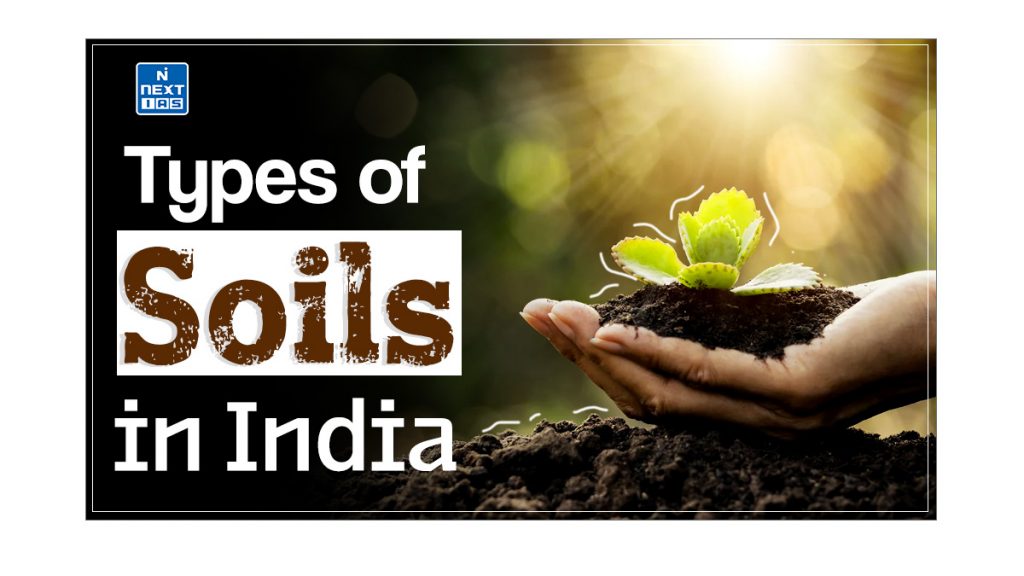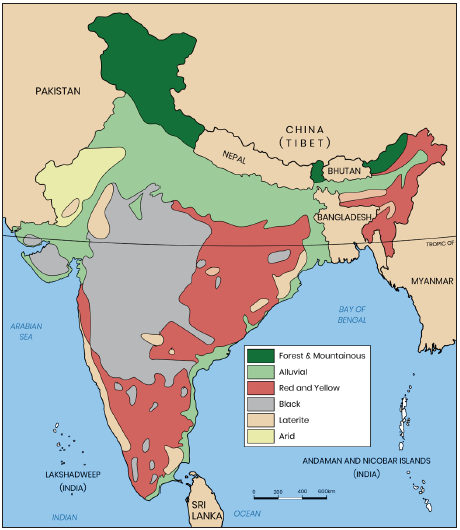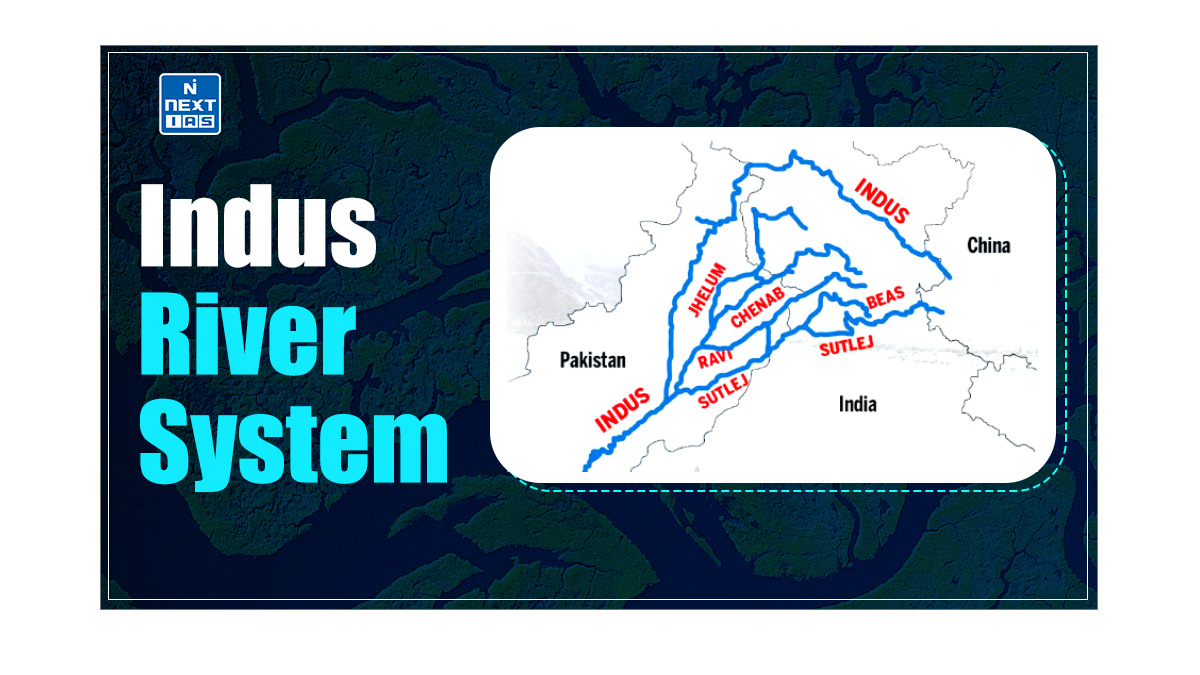
The types of soil in India highlight the diverse soil types that have been formed due to the country’s varied geography and climate. Understanding these soil types is crucial for optimising agricultural practices and ensuring sustainable land use. This article aims to study in detail the different types of soils found in India, their characteristics, chemical properties, and the crops best suited for each soil type.
What is Soil?
- Soil is the mixture of rock debris and organic materials that develop on the Earth’s surface.
- Mineral particles, humus, water, and air are the components of soil.
- Various forces of nature, such as changes in temperature, actions of running water, wind, glaciers, and activities of decomposers, contribute to the formation of soil.
- It takes millions of years to form soil up to a few centimetres in depth.
Read our detailed article on the Soils of India.
Types of Soils in India
- The varied relief features, landforms, climatic realms, and vegetation types of India have contributed to the development of various soil types in India.
- Based on this, the Indian Council of Agriculture Research (ICAR) classified soils into eight types:
- Alluvial Soils,
- Red Soils,
- Black Soils (Regur),
- Desert Soils,
- Laterite Soils,
- Mountain Soils,
- Alkaline Soils, and
- Peaty and Marshy Soils.
All these soils of India have been discussed in detail in the following section.

Alluvial Soils in India
- Alluvial soils in India occur mainly in the Indo-Ganga-Brahmaputra Plains, the valleys of Narmada and Tapi, and the Eastern and Western Coastal Plains.
- They are mainly derived from debris from the Himalayas or silt left out by the retreating sea.
- This is the largest soil group in India, covering about 46% of the total area and supporting more than 40% of the Indian population.
Characteristics of Alluvial Soil
- The alluvial soils’ colour varies from light grey to ash grey, and their texture is sandy to silty loam.
- These soils are both well-drained and poorly drained.
- In general, they have an immature profile in undulating areas, while in the levelled areas, they have a well-developed and mature profile.
Chemical Properties of Alluvial Soil
- The soil has low nitrogen content, whereas potash, phosphoric acid and alkaline are in adequate amounts.
Types of Alluvial Soil in India
The alluvial soils in India may be divided into the following:
Khadar Soil
- The Khadar Soils are low-lying and frequently inundated by floods during the rainy season.
- Thus, the khadar occupies the flood plains of the rivers and is enriched by fresh silt deposits every year.
- In the drier areas, it also exhibits stretches of saline and alkaline efflorescences locally known as reh, kallar, or thur.
Bhangar Soil
- It is above the flood level. It is generally well-drained but contains concretion (kankars) of impure calcium carbonate.
- The soil texture varies from loamy soil to clayey loam. It is well-drained and suited to wheat, rice, maize, sugarcane, pulses, oilseeds, barseem (fodder), fruits, and vegetables.
- Alluvial soils are rich in humus, phosphoric acid, lime, and organic matter. However, they are deficient in potash.
These are the best agricultural soil due to the following reasons:
- They contain a wide variety of salts derived from Himalayan rocks.
- They are light and porous, therefore easily tillable.
- Because of a high water table and an easily penetrable stratum, they are suitable for canal irrigation.
- However, as the water goes very deep, these soils are unsuitable for crops requiring water retention around the roots.
- These soils are rich in potash and poor in nitrogen and organic matter.
Red and Yellow Soil in India
- They are found mainly over the Peninsula from Tamil Nadu in the south to Bundelkhand in the north, Rajmahal in the east to Kathiawad and Kutch in the west.
- These soils are also found in tracts in western Tamil Nadu, Karnataka, southern Maharashtra, Andhra Pradesh, Chhattisgarh, Jharkhand, and Orissa and in scattered patches in Bundelkhand, Mirzapur, Sonbhadra (Uttar Pradesh), Banswara, Bhilwara, and Udaipur (Rajasthan).
Characteristics of Red and Yellow Soil
- They cover around 18.5% of India’s total geographical area.
- Their colour is mainly red because of the presence of ferric oxides.
- Generally, the top layer is red, while the horizon below is yellowish in colour.
- When hydrated, the soil appears yellow. The texture of red soils varies from sand to clay and loam.
- Their other characteristics include a porous and friable structure, the absence of lime, kankar, and carbonates, and a small quantity of soluble salts. They are mainly found in low-rainfall areas.
Chemical Properties of Red and Yellow Soil
- These soils are typically deficient in lime, phosphate, magnesia, nitrogen, humus, and potash.
- Intense leaching poses a significant threat to them.
- In the uplands, they are thin, poor, gravelly, sandy, or stony, and porous, with a light colour.
- However, in the lower plains and valleys, they are rich, deep, dark-coloured fertile loams.
Important Crops
- Places where irrigation water is available are devoted to wheat, cotton, pulses, tobacco, millets, oilseeds (linseed), potatoes, and orchards.
Black Soil in India
- Black soils, also known as Regur (cotton-soil). Getting their parent material from the weathered rocks of Cretaceous lava.
- They stretch over the greater parts of Gujarat, Maharashtra, western Madhya Pradesh, north-western Andhra Pradesh, Karnataka, Tamil Nadu, Rajasthan, Chhattisgarh, and Jharkhand, up to Rajmahal Hills.
- They are mature soils. Over the greater parts of the black Earth soil, the average annual rainfall varies between 50 and 75 cm.
- The colour of these soils varies from deep black to light black.
Characteristics of Black Soil
- They cover around 15% of India’s total geographical area. Moreover, these soils have a high water-retaining capacity.
- They are compact and tenacious when wet and develop wide cracks when dry.
- In other words, they swell greatly and become sticky when wet in the rainy season.
- When the soil is wet, plowing the field becomes difficult, as the plough gets stuck in the mud.
- In the dry season, the moisture evaporates, causing the soil to shrink and develop wide cracks, often 10-15 cm deep.
- This results in a natural ‘self-ploughing’ effect. Due to its slow absorption and gradual loss of moisture, black soil retains moisture for a long time, helping crops, especially rain-fed ones, to endure even during dry periods.
Chemical Properties of Black Soil
These soils generally have a clayey texture and are rich in iron, lime, calcium, potash, aluminium, and magnesium. However, they are deficient in nitrogen, phosphorous, and organic matter.
Important Crops
These soils are highly productive and thus well suited for cultivating cotton, pulses, millets, linseed, castor, tobacco, sugarcane, vegetables, and citrus fruits.
Desert Soil in India
- These soils are developed under arid and semi-arid conditions and deposited mainly by wind.
- They are found mainly in Rajasthan, west of the Aravallis, northern Gujarat, Saurashtra, Kutch, western parts of Haryana, and the south-western parts of Punjab.
Chemical Properties of Desert Soil
- They cover around 4.4% of the total geographical area.
- Desert soils are sandy to gravel, with low organic matter, low nitrogen, and a varying percentage of calcium carbonate.
- These soils contain a high percentage of soluble salts but have low moisture content and low water-retaining capacity.
- If irrigated, they give high agricultural returns.
Important Crops
- The availability of water from the Indira-Gandhi Canal has transformed the agricultural landscape of the desert soils of western Rajasthan.
- These soils are mainly devoted to bajra, pulses, guar, and fodder, and less water is required for crops.
Laterite Soil in India
- These are the typical soils of the monsoon climate, characterised by seasonal rainfall.
- With rain, lime and silica are leached away, leaving soil rich in iron oxide and aluminium, leading to the formation of laterite soil.
- The name is derived from the Latin word “later,” which means brick. Red laterite soil in Kerala, Tamil Nadu, and Andhra Pradesh is well suited for growing tree crops such as cashew nuts.
- Laterite soil hardens rapidly and irreversibly on exposure to the air, a property that leads to its use as building bricks in southern India.
Chemical Properties of Laterite Soil
- They cover around 3.7% of India’s total geographical area. The soil’s red colour is due to the presence of iron oxide.
- The soils in the higher areas are generally more acidic than those in the low-lying areas.
- These soils are rich in iron and aluminium but poor in nitrogen, potash, potassium, lime, and organic matter.
- Although they have low fertility, they respond well to manuring.
- These soils are found mainly in the plateau’s highlands, in the hills of the Western Ghats, Eastern Ghats, Rajmahal Hills, Satpura, Vindhya, Orissa, Chhattisgarh, Jharkhand, West Bengal, North Cachar Hills of Assam, and the Garo Hills of Meghalaya.
Important Crops
They are mainly devoted to rice, ragi, sugarcane, and cashew nuts.
Mountain Soil in India
- They cover around 3.7% of India’s total geographical area. The soil’s red colour is due to the presence of iron oxide.
- The soils in the higher areas are generally more acidic than those in the low-lying areas.
- These soils are rich in iron and aluminium but poor in nitrogen, potash, potassium, lime, and organic matter.
- Although they have low fertility, they respond well to manuring.
- These soils are found mainly in the plateau’s highlands, in the hills of the Western Ghats, Eastern Ghats, Rajmahal Hills, Satpura, Vindhya, Orissa, Chhattisgarh, Jharkhand, West Bengal, North Cachar Hills of Assam, and the Garo Hills of Meghalaya.
Saline and Alkaline Soils
- The saline soils are characterised by sodium chloride and sodium sulphate.
- In these soils, the saline and alkaline efflorescence appears on the surface as a layer of white salt through capillary action.
Chemical Properties of Saline and Alkaline Soils
- These soils vary from sandy to sandy loam texture.
- They are deficient in nitrogen and calcium and have very low water retention capacity.
- These soils can be reclaimed by improving drainage, applying gypsum and/or lime, and cultivating salt-resistant crops like barseem, dhaincha, and other leguminous crops.
- These soils are known by different names in different parts of the country.
- They are called reh, kallar, usar, rakar, thur, karl, and chopan.
- These soils are found in Rajasthan, Haryana, Punjab, Uttar Pradesh, Bihar, and Maharashtra.
Peaty and Marshy Soils in India
- Peaty soils originate in areas of heavy rainfall where adequate drainage is unavailable.
- They are generally submerged during the rainy season and used to cultivate rice.
Chemical Properties of Peaty and Marshy Soils
- These soils are rich in organic matter and highly saline but deficient in phosphate and potash.
- They mainly occur in parts of the Kottayam and Alappuzha districts of Kerala and the Sundarban delta.
- They are also found in the deltas of Mahanadi, Godavari, Krishna, Kaveri, and the Rann of Kutch.
Conclusion
The diverse soil types in India are a testament to the country’s varied geographical and climatic conditions. Each soil type has unique characteristics and properties influence its suitability for different crops and agricultural practices. The ICAR classification provides a comprehensive framework for this understanding, enabling farmers, policymakers, and researchers to make informed decisions for better crop yield and soil conservation. As India advances in agricultural science and technology, maintaining soil health and fertility will remain a cornerstone of its agricultural strategy.
Frequently Asked Questions (FAQs)
How many types of soil in India?
India has eight major types of soil: alluvial soil, black soil, red soil, laterite soil, arid soil, saline soil, peaty soil, and forest soil.
Where is black soil found in India?
Black soil is primarily found in the Deccan Plateau region of India, covering parts of Maharashtra, Madhya Pradesh, Gujarat, Andhra Pradesh, and Karnataka.
Where is alluvial soil found in India?
Alluvial soil is predominantly found in the Gangetic Plain, including the states of Uttar Pradesh, Bihar, West Bengal, and Punjab.
Where is red soil found in India?
Red soil is primarily found in the southern part of India, including states like Tamil Nadu, Karnataka, and Andhra Pradesh, as well as in parts of Madhya Pradesh and Odisha. It is characterised by its reddish colour due to iron oxide content.
Where is laterite soil found in India?
Laterite soil is primarily found in the Western Ghats, Northeast India, and along the coastal regions of Karnataka, Kerala, and Goa. It typically forms in tropical climates with high rainfall.






